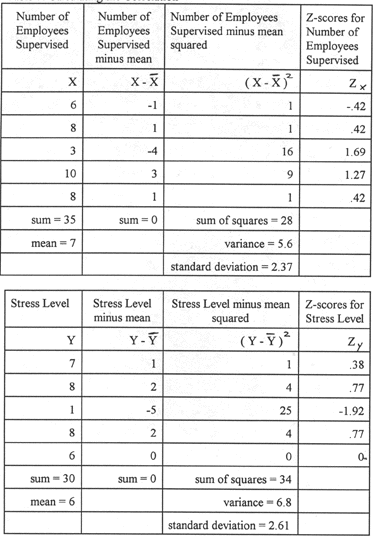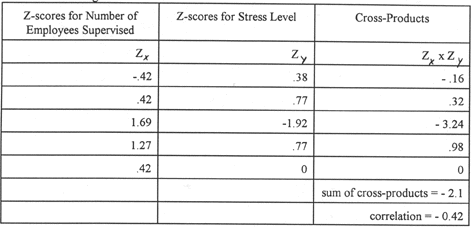Notes on Correlation
Continuation from
Correlation -- Step 4 and 5

Correlation -- Step
6
The sixth step is to convert all the
scores to z-scores. Remember, to do this you must take the raw score, subtract
the mean, and divide by the standard deviation. In the second column, we
have the raw score minus the mean for the variable AX. So if we take these
and divide them by the standard deviation for AX (2.37), we will have the
z-scores for AX.
In the ninth column, we have the raw
score minus the mean for the variable AY. So if we take these and divide
them by the standard deviation for AY (2.61), we will have the z-scores
for AY.
Be careful of your signs. Remember,
if you divide a positive number by a positive number, you get a positive
number. If you divide a negative number by a positive number, you get a
negative number.
|
Table 6
|

|

Correlation -- Step
7
The seventh step is to multiply the
z-scores for AX by the z-scores of AY. The results are called cross-products.
Remember your signs: if you multiply
two negative numbers together, you get a positive number. If you multiply
two posititive numbers together, you get a positive number. If you multiply
a positive number and a negative number, you get a negative number.
|
Table 7
|

|

Correlation -- Step
8
The eighth step is to sum these. The
result is called sum of cross-products. Remember your signs. The easiest
way I have found to do this is to add all the positive numbers together
(here you would get 4.54). Then add all the negative numbers together (here
you would get -.16). Then do 4.54 - .16).
Then divide the sum of cross-products
by the number of cross-products (here we have 5).
This is called the correlation!
In the first step where you plotted
the scores creating a scatter plot, did you determine that the correlation
would be positive? Did you determine that the correlation would be strong?
 Return
to Module 9 Notes
Return
to Module 9 Notes
|

